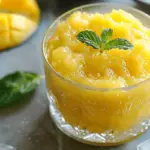Overview of the Keyword
Mango Puree is a versatile and delicious ingredient that can be used in a variety of recipes, from smoothies and desserts to marinades and sauces. This guide will provide you with everything you need to know about making and using mango puree, including tips on selecting the best mangoes, blending techniques, and creative uses.

Brief History and Cultural Significance
Mangoes have been cultivated for thousands of years, originating in South Asia and spreading to other tropical regions around the world. Mango puree has long been a staple in many cuisines, particularly in India, where it is used in both savory and sweet dishes. Today, mango puree is enjoyed globally for its rich flavor and nutritional benefits.
Preparation Phase & Tools to Use
Prep Time: 10 minutes
Cook Time: 0 minutes
Cool Time: 0 minutes
Total Time: 10 minutes
Servings: 2 cups
Yield: 2 cups of mango puree
To create the perfect mango puree, you’ll need the right tools and a bit of preparation. Here’s a detailed guide to get you started.
Essential Tools and Equipment
- Blender or Food Processor: These appliances are essential for achieving a smooth puree.
- Measuring Cups and Spoons: Precision is key in recipe making, so having accurate measuring tools ensures your ingredients are balanced.
- Strainer or Sieve: For an extra smooth texture, you may want to strain your puree to remove any fibrous parts.
- Storage Containers: Use airtight containers to store your puree and keep it fresh.
Importance of Each Tool
- Blender or Food Processor: Ensures the mango chunks are fully blended into a smooth puree.
- Measuring Tools: Help maintain the correct ratios of mango to any additional ingredients.
- Strainer or Sieve: Provides an extra step for achieving a silky texture by removing any fibrous bits.
- Storage Containers: Keeps your puree fresh and ready to use in various recipes.
Preparation Tips
- Choose Ripe Mangoes: Look for mangoes that are slightly soft to the touch and have a fruity aroma. Avoid mangoes that are overly mushy or have wrinkled skin.
- Chill Your Ingredients: Using cold mangoes can help maintain a fresh, vibrant flavor.
- Blend in Batches: If making a large quantity, blend in smaller batches to ensure a smooth consistency.
- Adjust Sweetness: Depending on your preference, you can add a bit of honey or sugar. For a tart twist, add a splash of lemon juice.
Ingredients List
- 2 ripe mangoes, peeled and diced
- 1-2 tablespoons water (optional, for thinning)
- 1 teaspoon lemon juice (optional, for flavor)
- 1 tablespoon sugar or honey (optional, for sweetness)
Step-by-Step Instructions
Creating the perfect mango puree involves a few simple steps, but attention to detail can make all the difference. Here’s a comprehensive guide:
- Prepare the Ingredients:
- Peel the mangoes and remove the pits. Dice the mango flesh into small chunks.
- Measure out 1-2 tablespoons of water, 1 teaspoon of lemon juice, and 1 tablespoon of sugar or honey if using.
- Blend the Ingredients:
- Add the diced mangoes to a blender or food processor.
- If desired, add water to achieve the desired consistency. This is optional and can help if the mangoes are not very juicy.
- Blend on high speed until the mixture is smooth and no chunks remain. This should take about 1-2 minutes.
- Check the Consistency:
- If the puree is too thick, add a bit more water and blend again.
- If it’s too thin, you can blend in more mango chunks to thicken it up.
- Strain (Optional):
- For an extra smooth puree, pass the blended mixture through a fine-mesh strainer or sieve to remove any fibrous parts.
- Add Sweeteners and Flavorings:
- If desired, stir in lemon juice and sweetener to taste. Blend again if necessary.
- Store:
- Transfer the mango puree to an airtight container. It can be stored in the refrigerator for up to 3 days or frozen for longer storage.
Side Dish Recommendations
Pairing your Mango Puree with the right dishes can enhance its tropical flavor and versatility. Here are eight side dish recommendations that complement the smooth and sweet taste of mango puree:
- Mango Smoothie
- Preparation: Blend mango puree with yogurt, banana, and a splash of orange juice.
- Why it Works: This smoothie is creamy and refreshing, perfect for a healthy breakfast or snack.
- Mango Sorbet
- Preparation: Freeze mango puree with a bit of lime juice and sugar. Blend again before serving.
- Why it Works: The tangy sorbet is a light and refreshing dessert that highlights the natural sweetness of mangoes.
- Mango Yogurt Parfait
- Preparation: Layer mango puree with Greek yogurt and granola.
- Why it Works: This parfait offers a balance of creamy, crunchy, and sweet elements, making it a satisfying and nutritious option.
- Mango Salsa
- Preparation: Mix mango puree with diced tomatoes, red onion, cilantro, and lime juice.
- Why it Works: This salsa is a vibrant, tangy addition to grilled fish or chicken.
- Mango Popsicles
- Preparation: Pour mango puree into popsicle molds and freeze.
- Why it Works: These popsicles are a healthy, hydrating treat for hot days.
- Mango Marinade for Meats
- Preparation: Mix mango puree with soy sauce, garlic, and ginger. Marinate chicken or pork before grilling.
- Why it Works: The mango adds a sweet and tangy flavor that enhances the savory taste of the meat.
- Mango Salad Dressing
- Preparation: Blend mango puree with olive oil, vinegar, and Dijon mustard.
- Why it Works: This dressing adds a tropical twist to salads, pairing well with leafy greens and nuts.
- Mango Oatmeal
- Preparation: Stir mango puree into cooked oatmeal and top with nuts and seeds.
- Why it Works: This makes for a delicious, fiber-rich breakfast with a boost of vitamins.
Nutritional Information & Health Benefits
Understanding the nutritional content and potential health benefits of Mango Puree can help you make informed decisions about enjoying this versatile ingredient.
Nutritional Breakdown (Per Serving)
- Calories: Approximately 60 per 100g
- Carbohydrates: 15g
- Sugar: 14g
- Fat: 0.2g
- Protein: 0.8g
- Fiber: 1.6g
Health Benefits of Key Ingredients
- Vitamins and Minerals: Mangoes are rich in vitamins A and C, which are essential for healthy skin, vision, and immune function. They also contain folate, vitamin E, and potassium.
- Antioxidants: Mangoes are packed with antioxidants, including beta-carotene and flavonoids, which help protect the body from oxidative stress and inflammation.
- Digestive Health: The fiber in mangoes aids digestion and helps maintain a healthy gut.
Tips for Making a Healthier Mango Puree
- Use Fresh Mangoes: Fresh, ripe mangoes provide the best flavor and nutritional benefits. Avoid canned mangoes with added sugars.
- Limit Added Sugars: If you prefer a sweeter puree, opt for natural sweeteners like honey or agave syrup instead of refined sugar.
- Add Nutrient Boosters: Enhance the nutritional profile by blending in other fruits, such as berries or citrus, or adding a handful of spinach for extra vitamins and minerals.
Common Mistakes to Avoid & How to Perfect the Recipe
Achieving the perfect Mango Puree requires attention to detail. Here are some common mistakes to avoid and tips to perfect your recipe:
- Over-blending
- Mistake: Blending for too long can cause the puree to become too thin and lose its texture.
- Tip: Blend just until smooth. If needed, blend in short bursts to control the consistency.
- Improper Ingredient Ratios
- Mistake: Using too much or too little liquid can affect the texture and flavor balance.
- Tip: Start with minimal liquid and add more as needed to achieve the desired consistency.
- Using Unripe Mangoes
- Mistake: Unripe mangoes can be too firm and sour, affecting the taste of the puree.
- Tip: Choose ripe mangoes that are slightly soft to the touch and have a fruity aroma.
- Not Chilling Ingredients
- Mistake: Using warm or room temperature ingredients can result in a less refreshing puree.
- Tip: Chill all your ingredients before blending to maintain a fresh, vibrant flavor.
- Ignoring Texture
- Mistake: The puree should be smooth and creamy, not chunky or fibrous.
- Tip: Use a high-powered blender and strain the puree if necessary to achieve a silky texture.
- Skipping Garnishes
- Mistake: Garnishes add visual appeal and can enhance the overall flavor experience.
- Tip: Add fresh mint leaves, a sprinkle of chia seeds, or a dash of cinnamon for an extra touch.
By avoiding these common mistakes and following the provided tips, you can perfect your mango puree recipe and enjoy its delightful flavor and versatility in various dishes.
Tips, Notes, Storing, and Reheating
Making a great Mango Puree is just the beginning. Here are some additional tips, notes, and advice on storing and reheating to ensure you always have a delicious puree on hand.
Additional Tips
- Experiment with Flavors: Don’t be afraid to add your twist to the classic mango puree. Try adding a splash of lime juice for a tangy kick, or infuse your puree with fresh mint for a refreshing twist.
- Use Crushed Ice: If you’re making a cold mango puree for drinks or desserts, blending with crushed ice can achieve a smoother texture.
- Sweetness Adjustments: If you prefer a sweeter puree, add a little simple syrup or honey. For a less sweet option, reduce the amount of added sweeteners.
Notes
- Alcohol-Free Version: For a non-alcoholic version of mango puree in cocktails, simply omit any alcohol and replace it with additional fruit juice or coconut water.
- Serving Suggestions: Serve your mango puree with a drizzle of honey or a sprinkle of cinnamon for an extra flavor boost.
Storing
- Refrigeration: Store any leftover mango puree in an airtight container in the refrigerator. It will stay fresh for up to 3 days.
- Freezing: For longer storage, pour the puree into ice cube trays and freeze. Once frozen, transfer the cubes to a freezer bag. They can be stored for up to 3 months.
Reheating
- Blending: To reheat (reblend) a refrigerated mango puree, add a few ice cubes and blend until smooth. This will restore its frothy texture.
- Defrosting: If using frozen puree cubes, allow them to thaw slightly at room temperature before blending or using in recipes.
FAQs
Can I make a non-alcoholic mango puree for cocktails?
Yes, simply omit the alcohol and replace it with extra fruit juice or coconut water. This creates a refreshing, non-alcoholic option.
What is the best type of mango for puree?
Choose ripe mangoes that are slightly soft to the touch and have a fruity aroma. Varieties like Ataulfo, Haden, and Kent work well due to their sweetness and smooth texture.
Can I use canned mangoes for mango puree?
While fresh mangoes are preferred for their flavor and nutritional benefits, canned mangoes can be used in a pinch. Ensure they are in natural juice or water, not syrup.
How can I make my mango puree thicker?
To make a thicker mango puree, reduce the amount of added liquid and blend more mango chunks. Straining out excess liquid can also help achieve a thicker consistency.
Is there a way to reduce the calorie content of mango puree?
Yes, use minimal added sweeteners and choose ripe, naturally sweet mangoes. You can also dilute the puree with a bit of water or coconut water to lower the calorie density.
What garnishes go well with mango puree?
Garnishes like fresh mint leaves, a sprinkle of chia seeds, a dash of cinnamon, or a drizzle of honey can enhance the flavor and presentation of mango puree.
Can I pre-make mango puree for a party?
Yes, you can make a large batch of mango puree ahead of time and store it in the refrigerator or freezer. Reblend just before serving to ensure the best texture.
What’s the difference between mango puree and mango pulp?
Mango puree is blended until smooth, often with added liquids for consistency, while mango pulp retains more of the fruit’s fibrous texture and is less processed.
How do I fix a mango puree that’s too watery?
If your mango puree is too watery, blend in more mango chunks or strain out excess liquid. This will help achieve a thicker consistency.
Conclusion
Mango Puree is a versatile and delicious ingredient that brings a taste of the tropics to any dish. By following this comprehensive guide, you can create the perfect recipe every time. From selecting the best mangoes to blending techniques and creative uses, you now have all the knowledge you need to enjoy this vibrant fruit. Don’t hesitate to experiment with flavors and techniques to make the recipe your own. Enjoy your delicious mango creations!
This concludes our ultimate guide to making the perfect recipe. We hope you found it informative and helpful. Enjoy your delightful tropical recipes!
Print
Mango puree
Description
Discover how to craft the perfect mango puree with our comprehensive guide, featuring history, tips, and delicious variations.
Ingredients
Ingredients List
- 2 ripe mangoes, peeled and diced
- 1–2 tablespoons water (optional, for thinning)
- 1 teaspoon lemon juice (optional, for flavor)
- 1 tablespoon sugar or honey (optional, for sweetness)
Instructions
Step-by-Step Instructions
Creating the perfect mango puree involves a few simple steps, but attention to detail can make all the difference. Here’s a comprehensive guide:
- Prepare the Ingredients:
- Peel the mangoes and remove the pits. Dice the mango flesh into small chunks.
- Measure out 1-2 tablespoons of water, 1 teaspoon of lemon juice, and 1 tablespoon of sugar or honey if using.
- Blend the Ingredients:
- Add the diced mangoes to a blender or food processor.
- If desired, add water to achieve the desired consistency. This is optional and can help if the mangoes are not very juicy.
- Blend on high speed until the mixture is smooth and no chunks remain. This should take about 1-2 minutes.
- Check the Consistency:
- If the puree is too thick, add a bit more water and blend again.
- If it’s too thin, you can blend in more mango chunks to thicken it up.
- Strain (Optional):
- For an extra smooth puree, pass the blended mixture through a fine-mesh strainer or sieve to remove any fibrous parts.
- Add Sweeteners and Flavorings:
- If desired, stir in lemon juice and sweetener to taste. Blend again if necessary.
- Store:
- Transfer the mango puree to an airtight container. It can be stored in the refrigerator for up to 3 days or frozen for longer storage.
Notes
- Experiment with Flavors: Don’t be afraid to add your twist to the classic mango puree. Try adding a splash of lime juice for a tangy kick, or infuse your puree with fresh mint for a refreshing twist.
- Use Crushed Ice: If you’re making a cold mango puree for drinks or desserts, blending with crushed ice can achieve a smoother texture.
- Sweetness Adjustments: If you prefer a sweeter puree, add a little simple syrup or honey. For a less sweet option, reduce the amount of added sweeteners.


Leave a Comment